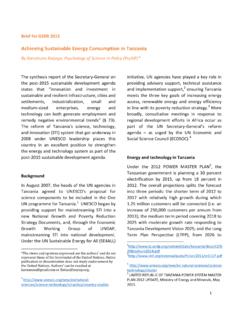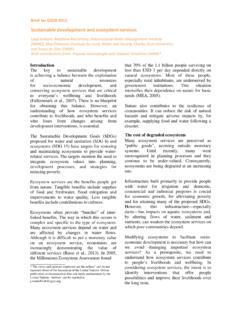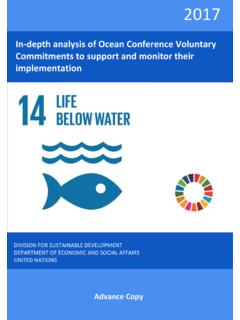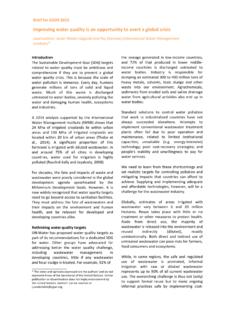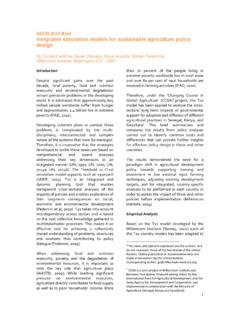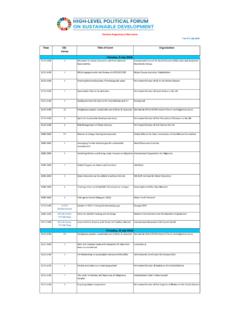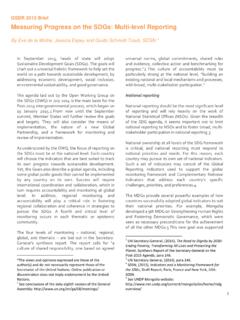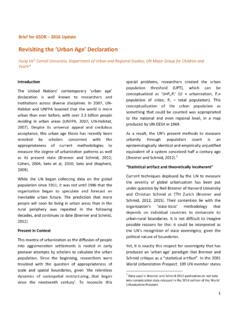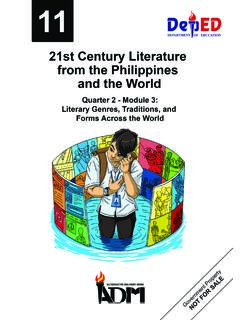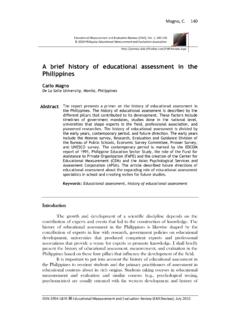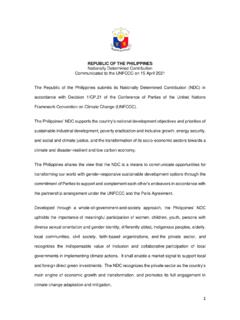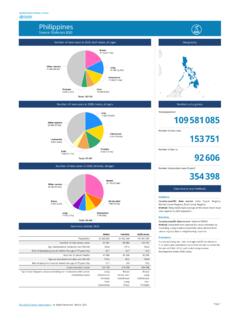Transcription of Table of Contents - United Nations
1 The 2019 Voluntary National Review of the Philippines 2 of 50 Table of Contents I. Introduction 3 II. Main Message of the philippine VNR 4 III. Methodology and Process of the Review 6 IV. Incorporation of the SDGs into National Frameworks 10 V. SDGs Monitoring 15 VI. Setting the National SDGs Numerical Targets 16 VII. Progress on the Goals and Targets: Integration of the Three Dimensions of Sustainable Development and Leaving No One Behind 17 Goal 4: Ensure inclusive and equitable quality education and promote lifelong learning opportunities for all 17 Goal 8: Promote sustained, inclusive and sustainable economic growth, full and productive employment and decent work for all 22 Goal 10: Reduce inequality within and among countries 27 Goal 13: Take urgent action to combat climate change and its impacts 30 Goal 16: Promote peaceful and inclusive societies for sustainable development, provide access to justice for all and build effective, accountable and inclusive institutions at all levels 34 SDG 17: Partnership for the Goals (Strengthen the means of implementation and revitalize the global partnership for sustainable development) 40 VIII.
2 How the International Community Can Help 46 IX. Means of Implementation and Next Steps 48 X. Conclusion 51 The 2019 Voluntary National Review of the Philippines 3 of 50 I. Introduction In September 2015, the Philippines, together with 192 other United Nations (UN) member states, committed to achieving the 17 Sustainable Development Goals (SDGs) and their 169 targets by 2030. The SDGs, also called the Global Goals, have a range of economic, social, environmental, and governance targets and there was recognition, early on, that these need to be achieved in order to attain the long-term vision as articulated in AmBisyon Natin 2040. The SDGs present a bold commitment to finish what has been started through the Millennium Development Goals (MDGs) in 2015. The Philippines affirms its commitment to achieve the SDGs by 2030, if not sooner, especially as the Global Goals are in sync with the country s development plans and long-term aspirations for 2040.
3 The Philippines, together with 50 other countries, is presenting its Voluntary National Review (VNR) of the SDGs to the 2019 High-Level Political Forum (HLPF) on Sustainable Development in New York from July 9 to 18, 2019. The 2019 VNRs are expected to focus on empowering people and ensuring inclusiveness and equality and will highlight Goals 4 (Quality Education), 8 (Decent Work), 10 (Reduced Inequalities), 13 (Climate Action), 16 (Peace, Justice and Strong Institutions), and 17 (Partnership for the Goals). The Philippines uses the VNR as venue to report on its progress on the SDGs, and plans to periodically participate in the VNR. This is to lend urgency to the development agenda of the SDGs, which is one of the lessons learned from the MDG-era implementation. For its first VNR conducted in July 2016, the Philippines focused on the lessons learned from the MDGs and how to build on its gains moving forward to the SDG era1.
4 For the second VNR, we will provide a thorough discussion on the milestones achieved and lessons learned focusing on the goals stated above. In conducting the VNR, the Philippines undertook several consultation workshops to gain feedback from stakeholders and to engage and renew commitments for cooperation towards the achievement of the goals. For this report, focus has been given to synergies between government and non-government actions that empower people and ensure inclusiveness and equality, particularly on deliberate efforts to reach out to the marginalized sector. 1 Some of the key findings of the Philippines first VNR are: (1) good governance is a key lesson the attainment of the MDGs requires a sustained and consistent commitment from all stakeholders (government, private sector, civil society, and development partners;); (2) there should be a clear implementation plan that covers institutional arrangements, communication and advocacy strategies, and financing plans; and (3) an appropriate data monitoring system to support the accountability mechanism should be in place -- and must be responsive to the demand for disaggregation of data and must ensure the timeliness of data collection so that policies and program designs benefit from up-to-date information.
5 The 2019 Voluntary National Review of the Philippines 4 of 50 II. Main Message of the philippine VNR Filipinos long for work-life balance, a comfortable, secure and peaceful life. This long-term aspiration AmBisyon Natin2 2040 was gleaned from a nationwide survey conducted in late 2015. This was about the time the Philippines adopted the 2030 Agenda for Sustainable Development, and subsequently crafted the philippine Development Plan (PDP) 2017-2022. The country soon recognized that it needed to transform the world by ensuring sustainable development and leaving no one behind in order to live the life we want. Sustainability and inclusivity are both goals and principles that guide development strategies of the country. Engaging stakeholders is necessary for an initiative to gain traction and be owned by a broad section of society who are driven to make it work and succeed. The Philippines second Voluntary National Review emphasizes the synergies between government and non-government actions required to ensure inclusiveness and equality.
6 The country has employed a whole-of-government and whole-of-society approach to SDG implementation. National actions are grounded in laws to ensure robustness. Cross-sectoral coordination and orchestration of actions are done through existing institutional mechanisms. Stakeholders are informed and engaged in discussions. The recently-launched SDG website provides a platform for broader engagement, including the youth and the Filipino diaspora. The primary catalyst for action is the PDP 2017-2022, which incorporates the SDGs. The PDP has subsequently been cascaded to the whole of government, including at the local level, following Executive Order No. 27 s. 2017. Nationally-determined 2030 numerical targets were identified, which set the required pace of progress of the SDGs. These targets are reflected in the Results Matrices, a companion document of the PDP. The philippine Statistics Authority monitors the Tier 1 indicators through their SDG Watch.
7 While government is both catalyst and mobilizer of the policy framework for the SDGs, even non-government stakeholders have taken on the responsibility for the agenda and delivering the services to the rights-holders. For quality education - the legal framework for institutionalizing the Alternative Learning System has been set. The Department of Education, working with the private sector, has been reaching out to what they call the last mile, which includes out-of-school youth and other vulnerable groups, to deliver education services. For decent work to allow for a just transition to a greener economy, the Philippines Green Jobs Act incentivizes enterprises to offer jobs using green production practices. The Securities and Exchange Commission will also require Sustainability Reports for Publicly Listed Companies, beginning 2020. Private businesses, such as cosmetics manufacturer Human Nature, are adopting inclusive business models, such as a value chain that deliberately involves disadvantaged communities.
8 The Mentor Me program of the Department of Trade and Industry further promotes mentoring and partnership between small and large enterprises. 2 AmBisyon Natin literally translates to Our AmBisyon. AmBisyon is a portmanteau of the Filipino words for Ambition and Vision. The 2019 Voluntary National Review of the Philippines 5 of 50 To reduce inequality - the Conditional Cash Transfer provides targeted interventions to disadvantaged families. Responding to Republic Act 10524 (otherwise known as the Magna Carta for Persons with Disability) which reserves employment for persons with disability, companies such as Lamoiyan Corporation employ handicapped people who comprise a significant proportion of their personnel. To offset regional disparities, the Assistance to Disadvantaged Municipalities provides a support fund for poorer local governments to build access roads, water systems, and reproductive health services, among others.
9 For climate action - the Climate Risk Management Framework provides risk information to enhance adaptive capacity. Project NOAH exemplifies the partnership between the academe and government in providing timely weather information for disaster preparedness. A ban on single-use plastics is already implemented in a number of cities and municipalities. A Sustainable Consumption and Production Action Plan is now being formulated to provide a coherent framework for climate action. For peace, justice, and strong institutions a major milestone is the ratification of the Bangsamoro Organic Law, which was a result of cumulative initiatives, including those by the international community, to address a long-standing conflict in southern Philippines. To ensure effectiveness of partnerships - the Philippines has been conducting the Official Development Assistance Portfolio Review. However, SDG implementation is still mostly financed from domestic resources.
10 Pursuing the SDGs requires an ambitious approach that gets everyone behind the goal of leaving no one behind. Involving the different stakeholders today in a very concrete way will determine the attainment of the SDGs in the remaining 11 years, and on to 2040. The 2019 Voluntary National Review of the Philippines 6 of 50 III. Methodology and Process of the Review The National Economic and Development Authority (NEDA), as the socioeconomic planning ministry of the Philippines, is in charge of coordinating the implementation of the SDGs using the process of overseeing the implementation of the PDP. Consistent with the theme of empowering people and ensuring inclusiveness and equality, the Philippines VNR prides itself on its consultative processes. One of the main motivations to conduct the VNR was to reinforce interest and commitment to the SDGs both from government and non-government actors. The VNR process ( Table 1) was utilized as an opportunity to connect with different stakeholders representing different sectors and geographic regions.

